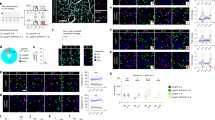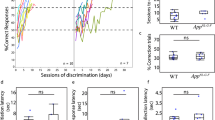Abstract
Experience-induced expression of immediate-early gene Arc (also known as Arg3.1) is known to be important for consolidation of memory. Using in vivo longitudinal multiphoton imaging, we found orchestrated activity-dependent expression of Arc in the mouse extrastriate visual cortex in response to a structured visual stimulation. In wild-type mice, the amplitude of the Arc response in individual neurons strongly predicted the probability of reactivation by a subsequent presentation of the same stimulus. In a mouse model of Alzheimer's disease, this association was markedly disrupted in the cortex, specifically near senile plaques. Neurons in the vicinity of plaques were less likely to respond, but, paradoxically, there were stronger responses in those few neurons around plaques that did respond. To the extent that the orchestrated pattern of Arc expression reflects nervous system responses to and physiological consolidation of behavioral experience, the disruption in Arc patterns reveals plaque-associated interference with neural network integration.
This is a preview of subscription content, access via your institution
Access options
Subscribe to this journal
Receive 12 print issues and online access
$209.00 per year
only $17.42 per issue
Buy this article
- Purchase on Springer Link
- Instant access to full article PDF
Prices may be subject to local taxes which are calculated during checkout






Similar content being viewed by others
Change history
30 August 2012
In the version of this article initially published online, the P-value for n.s. in Figure 2e was given as 0.13. The correct value is 0.09. The error has been corrected for the print, PDF and HTML versions of this article.
References
Shepherd, J.D. & Bear, M.F. New views of Arc, a master regulator of synaptic plasticity. Nat. Neurosci. 14, 279–284 (2011).
Korb, E. & Finkbeiner, S. Arc in synaptic plasticity: from gene to behavior. Trends Neurosci. 34, 591–598 (2011).
Ramírez-Amaya, V. et al. Spatial exploration-induced Arc mRNA and protein expression: evidence for selective, network-specific reactivation. J. Neurosci. 25, 1761–1768 (2005).
Tagawa, Y., Kanold, P.O., Majdan, M. & Shatz, C.J. Multiple periods of functional ocular dominance plasticity in mouse visual cortex. Nat. Neurosci. 8, 380–388 (2005).
Wang, K.H. et al. In vivo two-photon imaging reveals a role of arc in enhancing orientation specificity in visual cortex. Cell 126, 389–402 (2006).
Messaoudi, E. et al. Sustained Arc/Arg3.1 synthesis controls long-term potentiation consolidation through regulation of local actin polymerization in the dentate gyrus in vivo. J. Neurosci. 27, 10445–10455 (2007).
Chowdhury, S. et al. Arc/Arg3.1 interacts with the endocytic machinery to regulate AMPA receptor trafficking. Neuron 52, 445–459 (2006).
Shepherd, J.D. et al. Arc/Arg3.1 mediates homeostatic synaptic scaling of AMPA receptors. Neuron 52, 475–484 (2006).
Plath, N. et al. Arc/Arg3.1 is essential for the consolidation of synaptic plasticity and memories. Neuron 52, 437–444 (2006).
Eguchi, M. & Yamaguchi, S. In vivo and in vitro visualization of gene expression dynamics over extensive areas of the brain. Neuroimage 44, 1274–1283 (2009).
Cleary, J.P. et al. Natural oligomers of the amyloid-beta protein specifically disrupt cognitive function. Nat. Neurosci. 8, 79–84 (2005).
Shankar, G.M. et al. Amyloid-beta protein dimers isolated directly from Alzheimer's brains impair synaptic plasticity and memory. Nat. Med. 14, 837–842 (2008).
Koffie, R.M. et al. Oligomeric amyloid beta associates with postsynaptic densities and correlates with excitatory synapse loss near senile plaques. Proc. Natl. Acad. Sci. USA 106, 4012–4017 (2009).
Jankowsky, J.L. et al. Coexpression of multiple transgenes in mouse CNS: a comparison of strategies. Biomol. Eng. 17, 157–165 (2001).
Blakemore, C. & Cooper, G.F. Modification of the visual cortex by experience. Brain Res. 31, 366 (1971).
Sengpiel, F., Stawinski, P. & Bonhoeffer, T. Influence of experience on orientation maps in cat visual cortex. Nat. Neurosci. 2, 727–732 (1999).
Urbanc, B. et al. Neurotoxic effects of thioflavin S–positive amyloid deposits in transgenic mice and Alzheimer's disease. Proc. Natl. Acad. Sci. USA 99, 13990–13995 (2002).
Dickson, T.C. & Vickers, J.C. The morphological phenotype of beta-amyloid plaques and associated neuritic changes in Alzheimer's disease. Neuroscience 105, 99–107 (2001).
Jankowsky, J.L., Xu, G., Fromholt, D., Gonzales, V. & Borchelt, D.R. Environmental enrichment exacerbates amyloid plaque formation in a transgenic mouse model of Alzheimer disease. J. Neuropathol. Exp. Neurol. 62, 1220–1227 (2003).
Meyer-Luehmann, M. et al. Rapid appearance and local toxicity of amyloid-beta plaques in a mouse model of Alzheimer's disease. Nature 451, 720–724 (2008).
Spires, T.L. et al. Dendritic spine abnormalities in amyloid precursor protein transgenic mice demonstrated by gene transfer and intravital multiphoton microscopy. J. Neurosci. 25, 7278–7287 (2005).
Rozkalne, A., Hyman, B.T. & Spires-Jones, T.L. Calcineurin inhibition with FK506 ameliorates dendritic spine density deficits in plaque-bearing Alzheimer model mice. Neurobiol. Dis. 41, 650–654 (2011).
Maddox, S.A. & Schafe, G.E. The activity-regulated cytoskeletal-associated protein (Arc/Arg3.1) is required for reconsolidation of a Pavlovian fear memory. J. Neurosci. 31, 7073–7082 (2011).
Guzowski, J.F. et al. Inhibition of activity-dependent arc protein expression in the rat hippocampus impairs the maintenance of long-term potentiation and the consolidation of long-term memory. J. Neurosci. 20, 3993–4001 (2000).
Rial Verde, E.M., Lee-Osbourne, J., Worley, P.F., Malinow, R. & Cline, H.T. Increased expression of the immediate-early gene Arc/Arg3.1 reduces AMPA receptor-mediated synaptic transmission. Neuron 52, 461–474 (2006).
Koffie, R.M., Hyman, B.T. & Spires-Jones, T.L. Alzheimer's disease: synapses gone cold. Mol. Neurodegener. 6, 63 (2011).
Busche, M.A. et al. Clusters of hyperactive neurons near amyloid plaques in a mouse model of Alzheimer's disease. Science 321, 1686–1689 (2008).
Kuchibhotla, K.V. et al. Abeta plaques lead to aberrant regulation of calcium homeostasis in vivo resulting in structural and functional disruption of neuronal networks. Neuron 59, 214–225 (2008).
Grinevich, V. et al. Fluorescent Arc/Arg3.1 indicator mice: a versatile tool to study brain activity changes in vitro and in vivo. J. Neurosci. Methods 184, 25–36 (2009).
Lacor, P.N. et al. Synaptic targeting by Alzheimer's-related amyloid beta oligomers. J. Neurosci. 24, 10191–10200 (2004).
Perez-Cruz, C. et al. Reduced spine density in specific regions of CA1 pyramidal neurons in two transgenic mouse models of Alzheimer's disease. J. Neurosci. 31, 3926–3934 (2011).
Rosi, S. et al. Neuroinflammation alters the hippocampal pattern of behaviorally induced Arc expression. J. Neurosci. 25, 723–731 (2005).
Wu, J. et al. Arc/Arg3.1 regulates an endosomal pathway essential for activity-dependent beta-amyloid generation. Cell 147, 615–628 (2011).
Palop, J.J. et al. Aberrant excitatory neuronal activity and compensatory remodeling of inhibitory hippocampal circuits in mouse models of Alzheimer's disease. Neuron 55, 697–711 (2007).
Chen, T.J., Wang, D.C. & Chen, S.S. Amyloid-beta interrupts the PI3K-Akt-mTOR signaling pathway that could be involved in brain-derived neurotrophic factor–induced Arc expression in rat cortical neurons. J. Neurosci. Res. 87, 2297–2307 (2009).
Dickey, C.A. et al. Amyloid suppresses induction of genes critical for memory consolidation in APP + PS1 transgenic mice. J. Neurochem. 88, 434–442 (2004).
Dickey, C.A. et al. Selectively reduced expression of synaptic plasticity-related genes in amyloid precursor protein + presenilin-1 transgenic mice. J. Neurosci. 23, 5219–5226 (2003).
Echeverria, V., Berman, D.E. & Arancio, O. Oligomers of beta-amyloid peptide inhibit BDNF-induced arc expression in cultured cortical Neurons. Curr. Alzheimer Res. 4, 518–521 (2007).
Fox, L.M. et al. Soluble tau species, not neurofibrillary aggregates, disrupt neural system integration in a tau transgenic model. J. Neuropathol. Exp. Neurol. 70, 588–595 (2011).
Ginsberg, S.D., Hemby, S.E., Lee, V.M., Eberwine, J.H. & Trojanowski, J.Q. Expression profile of transcripts in Alzheimer's disease tangle-bearing CA1 neurons. Ann. Neurol. 48, 77–87 (2000).
Palop, J.J. et al. Vulnerability of dentate granule cells to disruption of arc expression in human amyloid precursor protein transgenic mice. J. Neurosci. 25, 9686–9693 (2005).
Wang, D.C., Chen, S.S., Lee, Y.C. & Chen, T.J. Amyloid-beta at sublethal level impairs BDNF-induced arc expression in cortical neurons. Neurosci. Lett. 398, 78–82 (2006).
Wegenast-Braun, B.M. et al. Independent effects of intra- and extracellular Abeta on learning-related gene expression. Am. J. Pathol. 175, 271–282 (2009).
Chin, J. et al. Fyn kinase induces synaptic and cognitive impairments in a transgenic mouse model of Alzheimer's disease. J. Neurosci. 25, 9694–9703 (2005).
Cuadrado-Tejedor, M. et al. Sildenafil restores cognitive function without affecting beta-amyloid burden in a mouse model of Alzheimer's disease. Br. J. Pharmacol. 164, 2029–2041 (2011).
Herring, A. et al. Exercise during pregnancy mitigates Alzheimer-like pathology in mouse offspring. FASEB J. 26, 117–128 (2012).
Hyman, B.T. et al. Quantitative analysis of senile plaques in Alzheimer disease: observation of log-normal size distribution and molecular epidemiology of differences associated with apolipoprotein E genotype and trisomy 21 (Down syndrome). Proc. Natl. Acad. Sci. USA 92, 3586–3590 (1995).
Palop, J.J. & Mucke, L. Amyloid-beta-induced neuronal dysfunction in Alzheimer's disease: from synapses toward neural networks. Nat. Neurosci. 13, 812–818 (2010).
Drzezga, A. et al. Neuronal dysfunction and disconnection of cortical hubs in non-demented subjects with elevated amyloid burden. Brain 134, 1635–1646 (2011).
Sperling, R.A. et al. Amyloid deposition is associated with impaired default network function in older persons without dementia. Neuron 63, 178–188 (2009).
Preibisch, S., Saalfeld, S. & Tomancak, P. Globally optimal stitching of tiled 3D microscopic image acquisitions. Bioinformatics 25, 1463–1465 (2009).
Acknowledgements
We thank A. Muzikansky (Harvard), B. Urbanc and B. Cohen (Drexel) for their help with statistical analysis. We also thank all the members of the Hyman laboratory for their input, discussions and help with the equipment. N.R. is supported by the fellowships from the Swiss National Science Foundation and the Swiss Foundation for Grants in Biology and Medicine. This research is supported by a gift from the Gilbert fund, grants from the US National Institutes of Health (AG033670 to T.L.S.-J. and AG08487 to B.T.H.) and a grant from the Harvard NeuroDiscovery Center to R.A.B.
Author information
Authors and Affiliations
Contributions
N.R., T.L.S.-J. and B.T.H. designed the experiments, analyzed the data and wrote the paper. N.R. and J.M.H. performed the experiments. M.E. and S.Y. generated Arc∷dVenus mice. R.A.B. contributed with statistical analysis of the data.
Corresponding author
Ethics declarations
Competing interests
The authors declare no competing financial interests.
Supplementary information
Supplementary Text and Figures
Supplementary Figures 1–4 and Supplementary Table 1 (PDF 1188 kb)
Rights and permissions
About this article
Cite this article
Rudinskiy, N., Hawkes, J., Betensky, R. et al. Orchestrated experience-driven Arc responses are disrupted in a mouse model of Alzheimer's disease. Nat Neurosci 15, 1422–1429 (2012). https://doi.org/10.1038/nn.3199
Received:
Accepted:
Published:
Issue Date:
DOI: https://doi.org/10.1038/nn.3199
This article is cited by
-
Tau and neuroinflammation in Alzheimer’s disease: interplay mechanisms and clinical translation
Journal of Neuroinflammation (2023)
-
Mechanisms and Functions of Activity-Regulated Cytoskeleton-Associated Protein in Synaptic Plasticity
Molecular Neurobiology (2023)
-
Increased mitochondrial calcium levels associated with neuronal death in a mouse model of Alzheimer’s disease
Nature Communications (2020)
-
Traceable stimulus-dependent rapid molecular changes in dendritic spines in the brain
Scientific Reports (2020)
-
Memory trace interference impairs recall in a mouse model of Alzheimer’s disease
Nature Neuroscience (2020)



